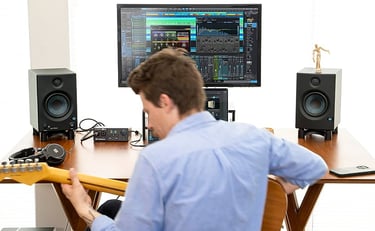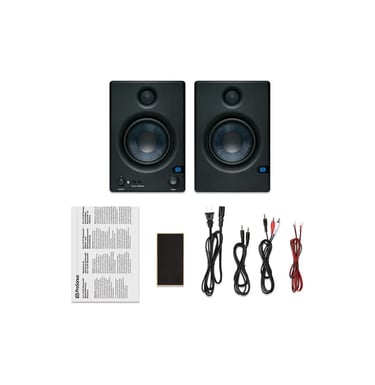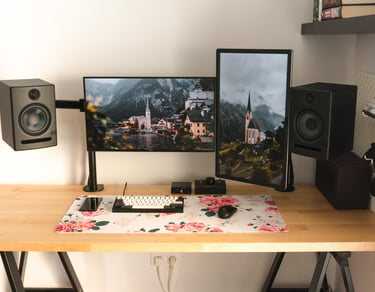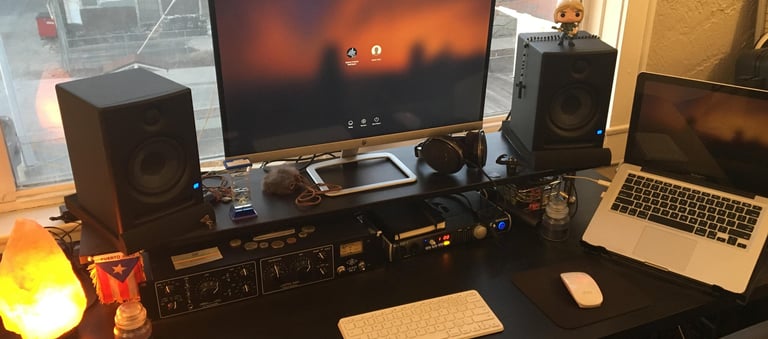
PreSonus Eris E5 Studio Monitor: A Thorough review for Beginners and Producers 2023
Chasebeatz
7/25/2023
Introduction
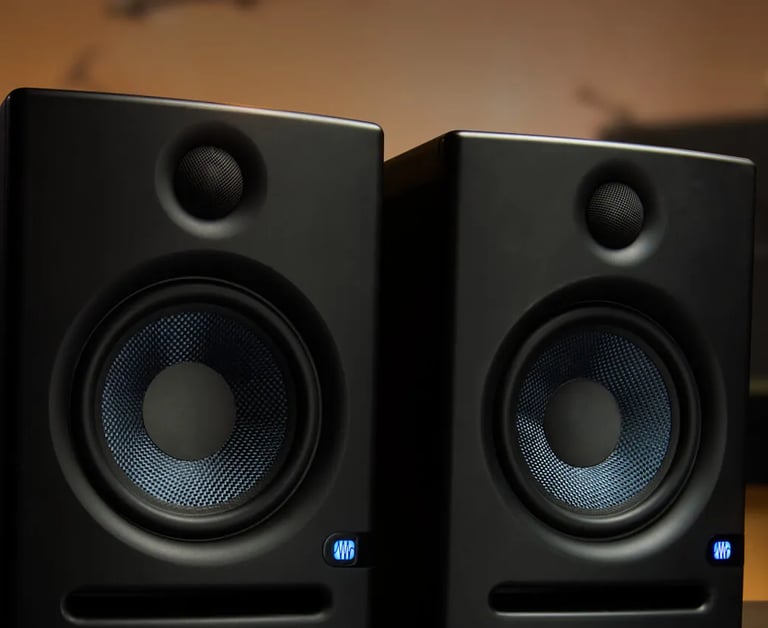

In the world of professional audio equipment, the Presonus Eris E5 stands tall as a beacon of excellence and precision.
Packed with innovative features and cutting-edge technology, this studio monitor has garnered a loyal following among audio enthusiasts and music producers alike.
In this blog post, we will delve into the depths of the Presonus Eris E5, exploring its unique features, design, and capabilities.
Whether you're a seasoned music producer or a beginner looking to take the first steps into the world of professional audio, the Eris E5 promises an unparalleled experience.
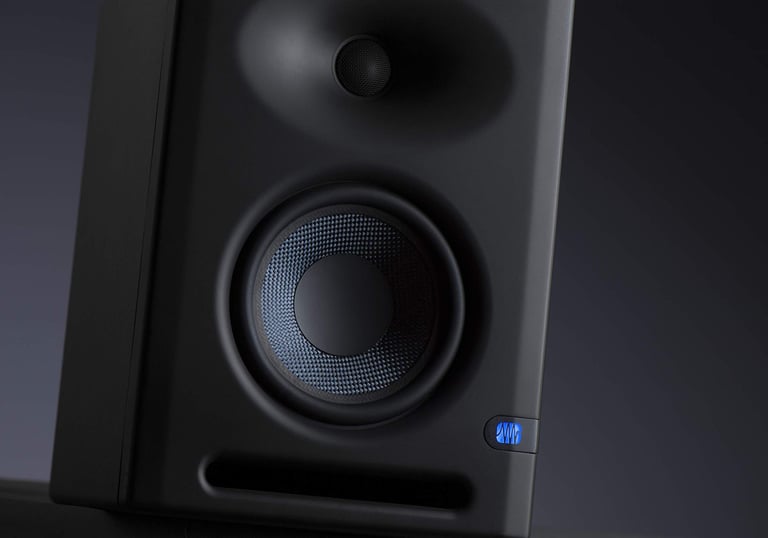

The PreSonus Eris E5 was introduced to the market in 2013. Despite its age, it remains a popular choice among producers due to its exceptional audio performance and reliability.
Many producers still use it to this day, attesting to its timeless appeal. The Eris E5 has received numerous positive reviews from users and professionals alike, solidifying its place as a trusted studio monitor.
For whom is this intended?
The PreSonus Eris E5 Studio Monitor is designed to cater to a diverse range of users, making it a versatile and valuable tool in various audio setups.
It is intended for music producers, engineers, and mixers who require accurate and transparent sound reproduction during recording, mixing, and mastering sessions.
The Eris E5's ability to deliver a flat and balanced frequency response makes it ideal for critical listening, allowing producers to make informed decisions and achieve polished and professional mixes
Overview and Legacy

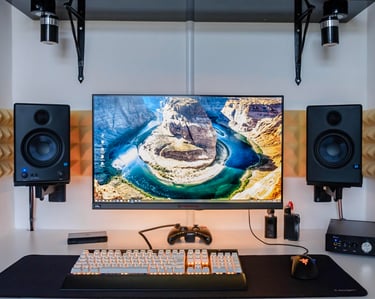
Design and built quality Eris E5 for music:
The Eris E5 boasts a sleek and professional design that blends seamlessly into any studio environment. Its construction is robust, ensuring durability to withstand the rigors of daily studio use.
The cabinet is made of high-quality MDF material, which minimizes resonance and delivers a more accurate sound. The front-firing bass port allows for proper airflow, reducing port turbulence and enabling a deeper, tighter bass response.
The PreSonus Eris E5 Studio Monitor is an excellent choice for music production across various genres and styles.
Its accurate sound reproduction and transparent sound signature make it a valuable tool for musicians, producers, and engineers working on music projects. Here's why the Eris E5 is well-suited for music production:
Accurate Sound Reproduction:
Music production demands precise monitoring to ensure that every element in the mix is accurately heard.
The Eris E5's balanced frequency response and detailed sound imaging allow musicians and producers to identify any flaws in the mix and make necessary adjustments for a polished final product.
Enhanced Bass Response:
The larger woofer of the Eris E5 enables a more extended bass response, which is particularly crucial for music genres that heavily rely on low-end frequencies, such as electronic dance music (EDM), hip-hop,
suitability for beginners and producers in general
The PreSonus Eris E5 Studio Monitor is an excellent choice for beginners starting out in music production.
It provides an accessible and user-friendly experience, allowing newcomers to the field to focus on honing their skills without being overwhelmed by complex features. Here are some reasons why the Eris E5 is well-suited for beginners:
User-Friendly Controls:
The Eris E5 features straightforward controls, including volume adjustments and acoustic tuning options, making it easy for beginners to set up and start using without much technical know-how.
Accurate Sound Reproduction:
The Eris E5 offers a balanced and accurate sound, which is crucial for beginners as it allows them to hear their tracks with clarity and make informed mixing decisions.
This feature helps newcomers learn the importance of maintaining a balanced frequency spectrum in their music.
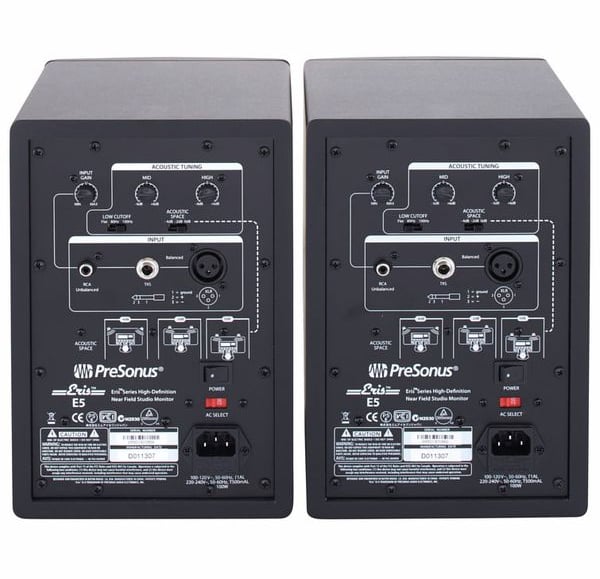

Learning Tool:
As beginners familiarize themselves with the Eris E5's sound signature, they can use it as a learning tool to develop their listening skills and train their ears to identify subtle nuances in their music.
Affordable Option:
The Eris E5 provides a high level of performance at a reasonable price point, making it an attractive option for those starting on a budget.
Suitable for Home Studios:
The compact size and versatile connectivity options of the Eris E5 make it ideal for home studio setups, where space may be limited.
Beyond being beginner-friendly, the PreSonus Eris E5 Studio Monitor is also a solid choice for producers at any level of expertise.
Its accurate and transparent sound reproduction, along with other advanced features, make it an excellent tool for professionals seeking a reliable studio monitor.
Here's why the Eris E5 suits producers in general:
Accurate Sound Imaging:
For experienced producers, having accurate sound imaging is vital for making precise mixing decisions.
The Eris E5's detailed soundstage ensures that every element in the mix is heard accurately, allowing producers to create well-balanced and polished tracks.
High-Quality Components:
The Eris E5's design incorporates high-quality components, such as the larger woofer and tweeter, ensuring better bass response and improved high-frequency reproduction.
These features enhance the overall audio quality, making it suitable for critical listening and mastering tasks.
Durability and Reliability:
Professional producers often require studio equipment that can withstand continuous use.
The Eris E5's robust build quality ensures that it can endure the demands of a busy studio environment, providing reliable performance over time.
Versatility in Mixing and Mastering:
Producers require studio monitors that can handle a wide range of musical genres and audio elements.
The Eris E5's wide frequency response and accurate reproduction enable producers to work across various genres and styles with confidence.
Cross-Referencing and Reference Mixes:
Seasoned producers often cross-reference their mixes on multiple playback systems to ensure the universality of their tracks.
The Eris E5's neutral sound signature allows producers to create reference mixes that translate well across different playback devices.
Mixing and mastering with the PreSonus Eris E5 Studio Monitor can significantly enhance your workflow and help you achieve professional-level results.
Here's a comprehensive guide on how to optimize your mixing and mastering process using the Eris E5:
Acoustic Environment:
Before diving into mixing and mastering, ensure that your studio space is acoustically treated. Proper acoustic treatment minimizes room reflections and standing waves, allowing you to hear an accurate representation of your music through the Eris E5.
Consider using bass traps, acoustic panels, and diffusers to create a more controlled listening environment.
Reference Tracks:
Begin your mixing process by listening to reference tracks on the Eris E5. These tracks should be songs that you admire in terms of their mix and master.
Pay attention to the balance of instruments, spatial effects, and overall tonal quality. This will help you set a benchmark for your own mix.
Balancing the Mix:
Start by setting all your track faders to unity (zero dB) and make sure none of the tracks are clipping.
Use the Eris E5's accurate sound reproduction to carefully balance the levels of each instrument and vocal in your mix.
Focus on achieving clarity and ensuring that each element can be heard distinctly.
Panning and Spatial Effects:
Use the Eris E5's detailed sound imaging to place instruments and vocals within the stereo field.
Experiment with panning and spatial effects to create a sense of depth and width in your mix.
Ensure that the mix sounds balanced when played in mono as well.
EQ and Frequency Balance:
The Eris E5's wide frequency response allows you to make precise EQ adjustments.
Use EQ to sculpt the individual tracks and ensure they sit well together in the mix.
Pay attention to the low-end frequencies to prevent muddiness and make sure the high-end is not too harsh.
Compression and Dynamics:
Use compression to control the dynamic range of individual tracks and ensure a consistent volume level throughout the mix.
The Eris E5's accuracy will help you hear subtle changes in dynamics, allowing for precise compression settings.
Reverb and Delay:
Apply reverb and delay effects tastefully to add space and depth to your mix. The Eris E5's transparent sound reproduction will help you avoid overusing these effects, which can muddy the mix.
Finalizing the Mix:
A/B test your mix on different playback systems and headphones to ensure its universality. Make any necessary adjustments based on these tests, taking advantage of the Eris E5's accuracy to fine-tune your mix.
Mastering Process:
When moving to the mastering stage, use the Eris E5 to critically listen to your final mix. Apply gentle mastering EQ and compression to enhance the overall tonal balance and dynamics. Avoid excessive processing that may negatively affect the mix's transparency.
Reference Mixing on Eris E5:
Before finalizing your master, listen to your mix on the Eris E5 alongside a professionally mastered reference track.
This will help you make any last-minute adjustments to achieve a commercial-level master.
In conclusion, the PreSonus Eris E5 Studio Monitor is an invaluable tool for mixing and mastering music.
Its accurate sound reproduction and transparent sound signature allow you to make critical decisions with confidence.
leading to polished and professional results in your music production endeavors.
How to leverage your mixing and mastering skills With Presonus Eris E5
In conclusion, the PreSonus Eris E5 Studio Monitor is suitable for both beginners and producers in general.
Its user-friendly features make it a great choice for those starting out in music production, while its accurate sound reproduction and high-quality components cater to the needs of experienced professionals.
Whether you're just beginning your music production journey or you're a seasoned producer looking for a reliable and accurate studio monitor, the PreSonus Eris E5 is a versatile and dependable option that will elevate your music production experience.
Technical Specifications:
Frequensy respond:
The PreSonus Eris E5 Studio Monitor offers a frequency response range of approximately 53Hz to 22kHz. This frequency response range covers a wide spectrum of frequencies, allowing the Eris E5 to reproduce deep, punchy bass frequencies as well as crisp, clear high frequencies.
The lower end of the frequency response (53Hz) provides a solid foundation for bass-heavy music genres like electronic dance music (EDM) and hip-hop.
This extended low-end response allows the Eris E5 to reproduce sub-bass frequencies with depth and accuracy, making it well-suited for monitoring bass-heavy tracks during mixing and mastering.
On the higher end of the frequency response (22kHz), the Eris E5 delivers detailed and sparkling high frequencies. This high-frequency extension ensures that delicate elements like cymbals, vocal sibilance, and high-frequency instruments are reproduced with clarity and precision.
Producers and engineers can rely on this accurate high-frequency reproduction to make critical adjustments in the mix and ensure that no subtle details are overlooked.
The balanced frequency response of the Eris E5 is a significant advantage for music production, as it allows users to hear their music accurately without any significant coloration or frequency bias.
This transparency ensures that the studio monitor does not impose its sonic signature on the music, enabling producers to make objective decisions during the mixing and mastering process.
Additionally, the Eris E5's frequency response is designed to be flat and consistent, which means that it aims to reproduce audio frequencies with equal volume levels across the entire spectrum.
This flat frequency response aids in achieving a balanced mix and ensures that the final master translates well across various playback systems and environments.
Overall, the PreSonus Eris E5's wide and balanced frequency response range is a key feature that contributes to its reputation as a reliable and accurate studio monitor for music production.
Wattage:
The PreSonus Eris E5 Studio Monitor is an active (powered) studio monitor that features a bi-amplified design, which means it has separate amplifiers for the woofer and the tweeter.
The total wattage of the monitor is typically expressed as the combined power output of both amplifiers.
The Eris E5 is equipped with an 80-watt Class AB amplifier for the low-frequency driver (woofer) and a 35-watt Class AB amplifier for the high-frequency driver (tweeter). This configuration provides a total power output of 115 watts.
The 80 watts dedicated to the woofer ensures ample power for delivering clear and punchy bass frequencies, while the 35 watts powering the tweeter ensures accurate and detailed high-frequency reproduction.
The bi-amplified design allows each driver to operate optimally and efficiently, resulting in a well-balanced and precise sound performance.
The power output of 115 watts makes the PreSonus Eris E5 Studio Monitor capable of producing sufficient volume levels for most studio setups and listening environments.
Whether you're working in a home studio or a professional recording space, the Eris E5's power ensures that you can hear your music accurately and at an appropriate level during the mixing and mastering process.
It's worth noting that the wattage of a studio monitor is not the only factor determining its overall performance. Other aspects, such as the quality of the drivers, the cabinet design, and the frequency response, all play a crucial role in delivering accurate and reliable sound reproduction.
The Eris E5's combination of power, quality components, and thoughtful design makes it a popular choice among musicians, producers, and engineers looking for a reliable and high-performing studio monitor.
Available inputs:
The PreSonus Eris E5 Studio Monitor offers a variety of input options, providing flexibility and compatibility with various audio sources.
These available inputs allow you to connect the Eris E5 to different devices, making it suitable for a wide range of music production setups.
The available inputs on the Eris E5 include:
Balanced XLR Input: The XLR input is commonly used in professional audio settings and provides a balanced connection, minimizing interference and noise. It is often used to connect the Eris E5 to audio interfaces, mixers, and other professional audio equipment.
Balanced ¼" TRS Input: The ¼" TRS (Tip-Ring-Sleeve) input is another balanced option commonly used in both professional and consumer audio devices. This input is often used to connect the Eris E5 to audio interfaces, audio mixers, keyboards, and other instruments with balanced outputs.
Unbalanced RCA Input: The RCA input is an unbalanced option that is commonly found on consumer audio devices, such as laptops, media players, and consumer-grade audio interfaces. It allows for a straightforward connection between the Eris E5 and these types of devices.
The availability of multiple input options on the PreSonus Eris E5 Studio Monitor makes it versatile and compatible with various studio and home studio setups.
Whether you're using professional-grade audio interfaces with XLR and TRS outputs or consumer-grade devices with RCA outputs, the Eris E5 can seamlessly integrate into your audio system and provide accurate monitoring for your music production needs.
PreSonus Eris E5 vs. E3.5: A thorough Comparison


Speaker Size and Driver Configuration:
The most noticeable difference between the Eris E5 and E3.5 lies in their physical size and driver configuration:
Eris E5:
The Eris E5 features a larger cabinet size, typically housing a 5.25-inch woven composite low-frequency driver (woofer) and a 1-inch silk dome high-frequency driver (tweeter).
Eris E3.5:
The E3.5 is more compact, equipped with a 3.5-inch woven composite low-frequency driver and the same 1-inch silk dome high-frequency driver found in the E5.
The larger woofer in the Eris E5 allows it to produce more extended and punchier bass frequencies compared to the E3.5. The difference in size and driver configuration translates to varying sound signatures.
making the E5 more suitable for genres that require pronounced bass presence, such as electronic music and hip-hop, while the E3.5 may be better suited for less bass-heavy genres like acoustic and vocal-focused productions.
Frequency Response:
The frequency response range of a studio monitor directly impacts its ability to reproduce different frequencies accurately. The Eris E5 and E3.5 have distinct frequency response specifications:
Eris E5:
The E5 typically offers a wider frequency response range compared to the E3.5, with ranges around 53Hz to 22kHz. This broader range allows the E5 to reproduce deep bass frequencies and crisp highs, providing a more comprehensive representation of your music.
Eris E3.5:
The E3.5 has a more limited frequency response, typically around 80Hz to 20kHz. While it still covers the essential midrange and high frequencies, its lower bass extension may not match the depth and impact of the E5.
For producers working on bass-heavy music genres or those aiming for more detailed sound representation across the entire frequency spectrum, the E5's wider frequency response range is a significant advantage.
However, the E3.5's response is sufficient for many applications, especially in smaller studio spaces.
Power Output:
Another crucial factor in studio monitor performance is the power output, which influences the monitor's ability to handle higher volume levels and maintain clarity under demanding conditions:
Eris E5:
The E5 typically features an 80-watt Class AB amplifier for the low-frequency driver and a 35-watt Class AB amplifier for the high-frequency driver, providing a total power output of 115 watts.
Eris E3.5:
The E3.5 has a lower power output compared to the E5, typically featuring a 25-watt Class AB amplifier for the low-frequency driver and a 15-watt Class AB amplifier for the high-frequency driver, offering a total power output of 40 watts.
The higher power output of the E5 allows it to handle louder listening levels and provides more headroom for dynamic music productions. This makes the E5 a preferred choice for larger studio spaces or those who prioritize volume capabilities during tracking or mixing sessions.
On the other hand, the E3.5's lower power output may be more suitable for smaller studio environments or individuals looking for a more compact solution. It is well-suited for home studios, content creators, and podcasters who may not require extremely high volume levels.
Sound Quality and Accuracy:
The sound quality and accuracy of studio monitors significantly impact the overall mixing and mastering process. Both the Eris E5 and E3.5 are designed to deliver high-quality sound, but their larger counterparts usually provide enhanced precision and detail:
Eris E5:
With its larger woofer and higher wattage, the E5 generally offers a more accurate and detailed sound reproduction, particularly in the low and high frequencies. This accuracy allows producers to make critical mixing decisions with confidence.
Eris E3.5:
The E3.5 delivers commendable sound quality within its compact size and power limitations. While it may not match the E5's level of precision, it still provides a reliable reference for mixing and mastering tasks.
The E5's larger size, coupled with its higher wattage, allows it to reproduce audio with improved clarity and separation, making it suitable for professionals and experienced producers seeking a more transparent listening experience.
The E3.5, while delivering good sound quality, may be more appropriate for beginners or those with limited space and budget constraints.
Price Point:
As with most audio equipment, the price point is a significant consideration for many users:
Eris E5:
The E5 typically sits at a higher price point compared to the E3.5, reflecting its larger size, wider frequency response, and increased power output.
Eris E3.5:
The E3.5 is generally more budget-friendly, making it an attractive option for those just starting their music production journey or working in smaller setups.
The price difference between the two models makes the E3.5 an appealing choice for budget-conscious users or those who prioritize a compact form factor.
On the other hand, the E5's higher price is justified by its enhanced features and performance, making it a worthy investment for professionals seeking uncompromising sound quality.
Room Size and Application:
Considering your studio space and intended use is essential when choosing between the Eris E5 and E3.5:
Eris E5:
The larger size and higher power output of the E5 make it better suited for medium to larger studio spaces. Its extended bass response and volume capabilities make it ideal for producers and engineers working in professional studios or larger home studios.
Eris E3.5:
The E3.5's compact size and lower power output make it more suitable for smaller studio spaces or bedroom setups. Its portability and affordability make it an excellent choice for beginners, content creators, podcasters, and those with limited space.
Conclusion:
In conclusion, the PreSonus Eris E5 and E3.5 cater to different user preferences and studio requirements. The Eris E5 offers a larger size, wider frequency response, higher power output, and enhanced sound accuracy, making it suitable for professionals and those working in larger studio spaces.
Its larger woofer allows for deeper bass reproduction, which can be advantageous for bass-heavy music genres. Conversely, the Eris E3.5 offers a more compact and budget-friendly option, making it ideal for beginners or those with limited space and budget constraints.
Its performance, though slightly limited compared to the E5, is still sufficient for many music production applications, especially in smaller studio environments.
Ultimately, the choice between the Eris E5 and E3.5 depends on your specific needs, room size, budget, and the level of accuracy you require in your music production process. Both models offer reliable and reputable sound quality, making them valuable additions to any studio setup.
Accurate Sound Reproduction: The Eris E5 delivers a flat and balanced frequency response, providing accurate sound reproduction without coloration. This allows producers and engineers to make critical mixing decisions with confidence.
Wide Frequency Response: With a frequency response range of approximately 53Hz to 22kHz, the Eris E5 covers a broad spectrum of frequencies, including deep bass and clear highs, making it suitable for various music genres.
Enhanced Bass Response: The larger 5.25-inch woofer allows for extended bass reproduction, delivering punchy and well-defined low frequencies ideal for bass-heavy music genres like EDM and hip-hop.
Clear High-Frequency Detail: The 1-inch silk dome tweeter provides crisp and detailed high-frequency reproduction, ensuring that delicate elements such as vocals and cymbals are accurately represented.
Powerful Amplification: The bi-amplified design with an 80-watt woofer amplifier and a 35-watt tweeter amplifier delivers a total power output of 115 watts, providing ample headroom and handling higher volume levels.
Versatile Input Options: The Eris E5 offers balanced XLR and ¼" TRS inputs for professional audio equipment, as well as an unbalanced RCA input for consumer-grade devices, providing flexibility in connecting to various audio sources.
Solid Build Quality: The Eris E5 is well-constructed with a sturdy cabinet and front-firing bass port, ensuring durability and reduced resonance for cleaner sound.
Acoustic Tuning Controls: The rear panel features acoustic space settings, high-frequency, and low-frequency controls, allowing users to adjust the monitor's response to fit different room acoustics.
Pros:
Cons:
Size and Weight: The Eris E5's larger size and weight may be less suitable for compact studio setups or portability requirements.
Price: As a more advanced and powerful studio monitor, the Eris E5 is generally more expensive compared to smaller models or entry-level options.
Placement Challenges: Due to the front-firing bass port, proper positioning away from walls or corners may be required to avoid undesirable bass resonance.
Limited Midrange Detail: While the Eris E5 excels in bass and high-frequency reproduction, some users may find the midrange detail slightly less pronounced in comparison.
Room Acoustic Dependence: Like any studio monitor, the Eris E5's performance can be affected by the room's acoustic treatment, emphasizing the importance of proper room setup and acoustic treatment.
When it comes to studio monitors, finding the right fit for your music production needs is crucial.
PreSonus, a reputable name in the audio industry, offers a range of studio monitors, including the Eris E5 and E3.5 models.
Both monitors have garnered positive reviews and gained popularity among music producers, but they have significant differences and upgrades that cater to specific use cases.
Let's dive deeper into the comparison between the PreSonus Eris E5 and E3.5 to understand their respective strengths and applications.
Conclusion:
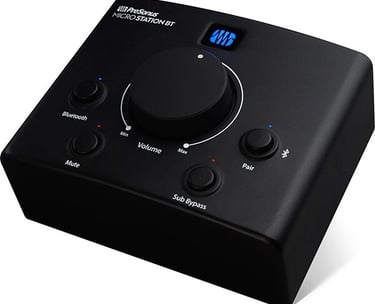

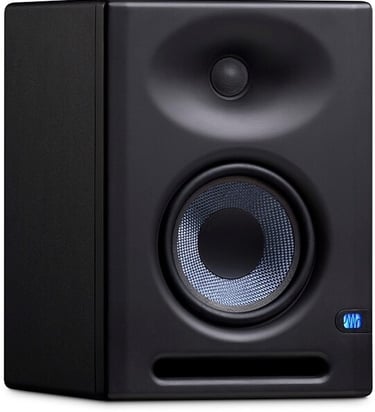

In conclusion, the PreSonus Eris E5 Studio Monitor is an outstanding choice for both beginners and seasoned producers alike. Its accurate sound reproduction, durable design, and user-friendly features make it a reliable tool for music production.
While there may be minor drawbacks, the overall performance and legacy of the Eris E5 make it a worthwhile investment for anyone seeking a top-tier studio monitor.
Whether you're just starting your music production journey or you're a professional looking for a dependable monitor, the PreSonus Eris E5 is a solid choice that will elevate your audio monitoring experience.
Thank you for joining us on this journey through the world of Presonus Eris E5 Studio monitor.
Stay Tuned for the Next Installment!!
Presonus Eris E5: $99.99
PreSonus MicroStation Monitor controller: $99.99-$349.99
Please note that some of the links provided in this content may be affiliate links. This means that if you make a purchase through those links, I may earn a commission at no additional cost to you.


Chase
full-time Music Producer with over 4 years of experience using Ableton Live D.A.W. Chase will help you develop your music production abilities with tutorials, challenges, and also home studio gear reviews.


Get connected


ChaseBeatz is a budding music production business dedicated to crafting dynamic and engaging beats for emerging artists. With a focus on providing affordable and high-quality productions, ChaseBeatz helps aspiring musicians bring their creative visions to life, offering a solid foundation for their musical journey.


